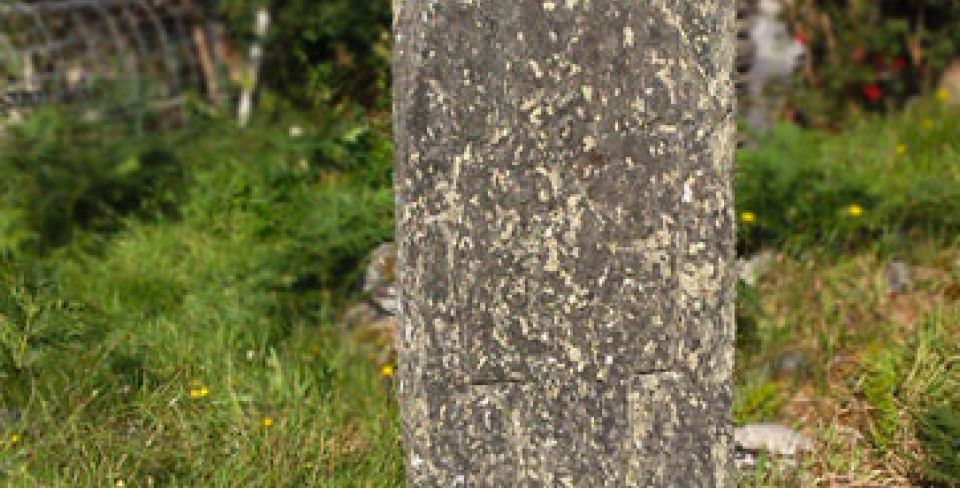1.12 Baile nan Deamhan
12. Baile na nDeamhan
This stone is decorated on both sides with interlocking patterns. The Baile na nDeamhan – village of the demons – is where Colmcille is said to have been attacked by demons.© Julia Gillen
Manus O’Donnell’s Life of Colum Cille is the source of legends linking Colmcille with this area. Written in 1532, it drew together the stories known and told about Colmcille at the time. O’Donnell’s book described how Colmcille drove evil spirits out of Gleann Cholm Cille,
‘When Patrick had banished and driven away the evil spirits from Cruachan Aigle, today known as Croagh Patrick, a crowd of them went to the place called Senglenn Colum Cille [Glencolumbkille] in the territory of Cenél Conaill…And they raised a mist around them so that no one could see the ground beneath that mist. And they made a fiery stream of the [Glen] river which borders the north side of that place so that no one could get across it. And anyone who would touch that stream, to a greater or lesser extent, would die immediately.
The angels of God revealed this to Colum Cille and he went with many of the other saints to drive away and banish the devils out of that place. And they camped beside the aforementioned fiery stream. They were not there long when the Devil hurled a holly spear across the stream out of the mist. The bolt killed An Cerc [literally: ‘the hen’], Colum Cille’s servant, so that Srath na Circe [‘The place of Cerc’] is the name of that place since then.
That angered Colum Cille greatly and he seized the same spear and hurled it back across the stream. And the land was yielded to him as the spear travelled towards the mist, for the mist fled before Colum Cille’s cast. And the spear grew in the place where it struck the ground that time so that it is now a fresh holly tree that never withered since then, and as it will be forever.
After that Colum Cille blessed the stream and its venom and magic left it; then he crossed it. And an angel brought him a round green stone and told him to throw it at the demons so that they and the mist would flee before it. The angel also told him to throw his own bell, the Dub Duaibsech, at them. Colum Cille did as the angel commanded so that all the land was yielded to him from the mist and the demons escaped to a rock out in the sea opposite the western headland of that place…And he ordered the demons to go into the sea through that rock where they were, and to be in the form of fish there forever and to do no devilment on anyone from then on. And they had to do that because of the words of Colum Cille. And a man with his clothes on could go through the hole they made in the rock when they went through it into the sea. And, fearing that anyone would eat them, Colum Cille left a sign on them, different from any other fish, that is that they are red and blind in one eye. Fishermen often catch them today but, recognising them, they do nothing with them except throw them back into the sea again.
Colum Cille asked God then to give him back his bell and stone from the sea and with that he saw them coming towards him like a fiery glow, and they fell beside him. Colum Cille blessed that ground from where he had banished the bad spirits and he left the right of the sanctuary on it from then on. And he left the stone as the chief treasure, working miracles and marvels. The bell went deep into the earth in the place where it fell and left its clapper there. Colum Cille said that the bell was no worse without its clapper and, if any person dishonoured the sanctuary, the bell should be put in the hole where it had left its clapper as a sign of a curse upon him, and he wold not live out one year. And that has been proven frequently.’
Gleann Cholm Cille
- 1.1 Straid Court Tomb
This is the ruined remains of a burial tomb dating from about 3,000BC. It was made and used by farmers who lived in Gleann Cholm Cille. It is pre-Christian but has been incorporated into the Turas Cholmcille pilgrimage trail around the glen. The tomb is now used as the starting...
- 1.2 Cross Pillar
This cross is almost 2 metres tall and is decorated with carved designs on both sides. It is a Christian monument probably made around 700-800AD. The east-facing side is decorated with rectilinear panels, each one with a rectangular boss in the centre. The west side has four patterns on it....
- 1.3 Garvecross Cairn
3. Áit na nGlún Áit na nGlún - The Place of the Knees - is a cairn. To the side there is a flat stone slab with a round stone on top. After circling the cairn, pilgrims pass this smaller stone around their bodies as they pray.
- 1.4 Cross Pillar, Beefan
4. Mullach na Croise Mullach na Croise - Height of the Cross - is a stone pillar carved with the faint outline of a cross. It stands in the centre of a cairn. Both the cairn and cross lie within the remains of a circular enclosure. Pilgrims following the turas walk round...
- 1.5 Colmcille’s Chapel, Beefan
© Julia Gillen 5. Beefan Colmcille's Chapel According to local tradition, this is the site of Colmcille’s chapel in Gleann Cholm Cille where the saint prayed and worked on illuminated manuscripts. Nearby there are three stone slabs with Christian carvings. It is said that Colmcille came to Gleann Cholm Cille...
- 1.6 Colmcille’s Chair
6. Colmcille's Chair Legend has it that this is where Colmcille sat to rest, looking down at the valley below him. Some claim that a wish made here will come true. There is some debate locally about how the stations on the turas in Gleann Cholm Cille should be numbered....
- 1.7 Colmcille’s Well
© Mindie Burgoyne 7. Tobar Colm Cille Tobar Colm Cille - Colmcille’s Well - is surrounded by a large stone cairn. Pilgrims pick up three stones as they walk up the hill and each time they circle the cairn, they throw stone onto it. Pilgrims also drink from the well and often...
- 1.8 Colmcille’s Garden
8. Garraí an Turais Garraí an Turais - the turas field - is also known as Colmcille’s Garden. The area contains a set of three upright stones, two of which are carved with a simple cross. Each stone is surrounded by a cairn and all are enclosed by a stone wall. Pilgrims...
- 1.9 Cloch na Aonaigh
9. Cloch na Aonaigh The Stone of the Gathering - Cloch na Aonaigh - is nearly 2 metres tall and faces pilgrims as they arrive across the valley floor. The stone is carved on both sides with circular and linear patterns. After circling the stone three times, pilgrims stand with their back...
- 1.10 An Fhothair
10. An Fhothair This turas station is a cairn with an upright stone slab standing at its centre. The cairn lies in the middle of field. The stone faces east/west and there are views down to the Church of Ireland church beyond. Pilgrims circle the stone three times as they...
- 1.11 An Droim Rua
11. An Droim Rua Turas station 11 is an upright stone in a cairn. The stations at this point of the turas are near each other on either side of the road. It may be that the current road follows the line of an ancient pilgrimage route.
- 1.12 Baile nan Deamhan
12. Baile na nDeamhan This stone is decorated on both sides with interlocking patterns. The Baile na nDeamhan - village of the demons - is where Colmcille is said to have been attacked by demons.© Julia Gillen Manus O’Donnell’s Life of Colum Cille is the source of legends linking Colmcille with this area. Written...
- 1.13 An Gaineamh
13. An Gaineamh This stone stands right beside the road. The original was damaged and this fibreglass replica was made based on the original pieces. It is only carved on one side and faces east/west. The carved side of the stone faces pilgrims as they head west along the road....
- 1.14 An Caiseal
14. An Caiseal This is a tall pillar carved with two circular patterns. Like many of the Christian cross slabs in Gleann Cholm Cille this may date from the late 7th to 9th century.
- 1.15 An tSráid
15. An tSráid This cross slab is now in two parts with the upper part sitting on the ground to the left of the lower part. It is carved with three complex patterns, linked by a vertical line. This station is now the last on the turas although traditionally pilgrims...










Bòrd na Gàidhlig
Great Glen House
Leachkin Road
Inverness
Scotland, IV3 8NW
(+44) 01463 225454
colmcille@gaidhlig.scot
Colmcille
Foras na Gaeilge, 2-6 Queen Street
Belfast
Northern Ireland
BT1 6ED
(+44) 028 9089 0970
colmcille@forasnagaeilge.ie
Colmcille
Foras na Gaeilge, An Chrannóg
Na Doirí Beaga
Gaoth Dobhair
Donegal, Ireland. F92 EYT3
(+353) 074 9560113
colmcille@forasnagaeilge.ie


